Drinking Water Protection
- Drinking Water Protection Home
- About Us
- A-Z Index of Contaminants in Water
- Community Public Water Supply
- Drinking Water Grants and Loans
- Drinking Water Institute
- Drinking Water in Schools and Child Cares
- Drinking Water Revolving Fund
- Laws and Rules
- Noncommunity Public Water Supply
- Source Water Protection
- Water Operator and Certification Training
- Drinking Water Protection Contacts
Related Topics
- Annual Reports
- Drinking Water Risk Communication Toolkit
- Drinking Water Protection External Resources
- Fact Sheets
- Forms
- Invisible Heroes Videos: Minnesota's Drinking Water Providers
- Noncom Notes Newsletter
- Sample Collection Procedures (videos, pictures, written instructions)
- Waterline Newsletter
Related Sites
- 10 States Standards
- Clean Water Fund
- Health Risk Assessment – Guidance Values and Standards for Water
- Minnesota Well Index
- Water and Health
- Wells and Borings
Environmental Health Division
Waterline: Summer 2018

Editor:
Stew Thornley
Subscribe to The Waterline newsletter. An e-mail notice is sent out each quarter when a new edition is posted to the web site.
On this page:
- Water in Southeastern Minnesota
- Water Poster Contest 2018
- Jim Sadler Retires
- Mark Sloan Dies
- Sustainability Key to Rochester Water
- Lewis & Clark Summary
- Austin Utilities Increases Capacity to Serve Major Spam Producer
- Water Quality Incident? Contact the State Duty Officer
- 2018 Drinking Water Institute August 6-8
- Mankato Receives Source Water Protection Award
- Summit Brewing Company: It Starts with the Water
- Invisible Heroes Videos Highlight Drinking Water Protection
- We Are Water MN Visits the Capitol
- Words to Live By
- Reminder to All Water Operators
- Calendar
Water in Southeastern Minnesota
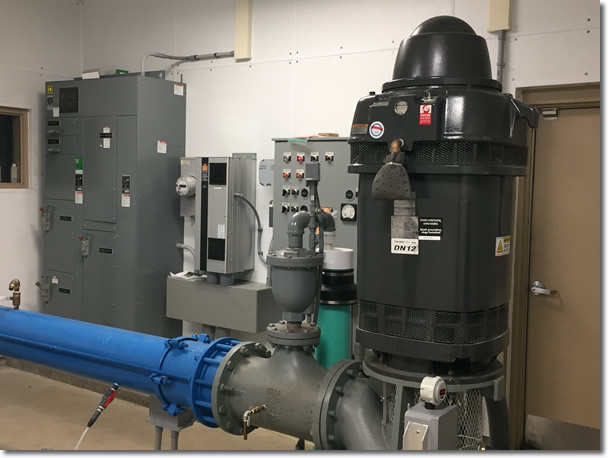 |
|
More than 30 wells keep Rochester, Minnesota, afloat to serve residents as well as the world’s most prominent medical organization. Rochester Public Utilities has focused on sustainability as it serves customers in the state’s third-largest city. See the full story on Rochester. Another city in the southeastern part of Minnesota, Austin, has opened a new municipal center and increased its capacity to serve Hormel, the major Spam producer that has switched to city water. See below for more information. |
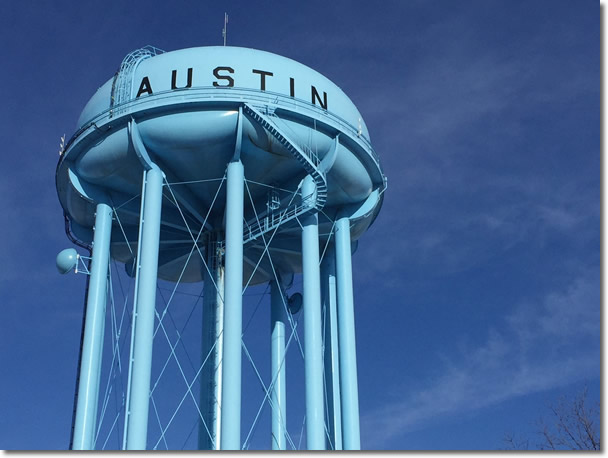 |
Go to top
Water Poster Contest 2018
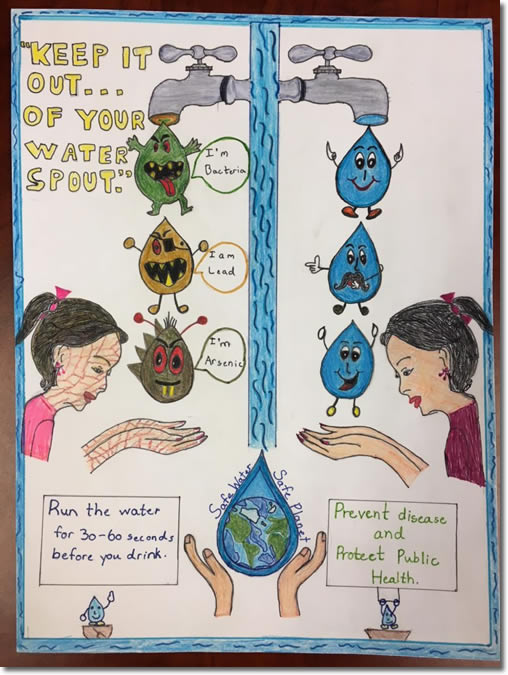 Sarvagna Vempati, a second-grader at Basswood Elementary, submitted the winning poster in the elementary school category in the annual water poster contest sponsored by H2O for Life and the Minnesota Department of Health, which provide bottle-filling stations to the schools of the winning entries. The theme of the contest was “Keep It Out . . . of Your Water Spout” with an emphasis on reducing exposure to lead and other contaminants. Other winners were Caden Blix of Ordean East Middle School in the middle school category and Krystal Xiong of Hmong College Prep Academy among high schoolers.
Sarvagna Vempati, a second-grader at Basswood Elementary, submitted the winning poster in the elementary school category in the annual water poster contest sponsored by H2O for Life and the Minnesota Department of Health, which provide bottle-filling stations to the schools of the winning entries. The theme of the contest was “Keep It Out . . . of Your Water Spout” with an emphasis on reducing exposure to lead and other contaminants. Other winners were Caden Blix of Ordean East Middle School in the middle school category and Krystal Xiong of Hmong College Prep Academy among high schoolers.
Go to top
Jim Sadler Retires
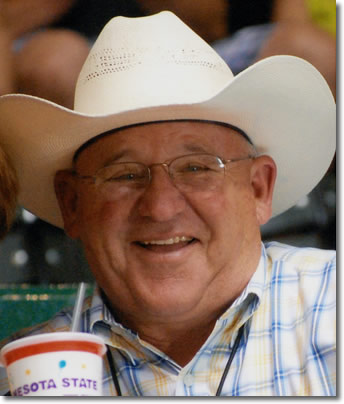 Jim “Bulldog” Sadler retired March 30 after 42 years with the city of Maple Grove. After graduating from Osseo High School in 1970, Jim worked in construction and then joined the Maple Grove street department in November 1976. Five months later he moved to utilities, and he became utilities superintendent in 1998.
Jim “Bulldog” Sadler retired March 30 after 42 years with the city of Maple Grove. After graduating from Osseo High School in 1970, Jim worked in construction and then joined the Maple Grove street department in November 1976. Five months later he moved to utilities, and he became utilities superintendent in 1998.
Bulldog (a nickname acquired through American Water Works Association) has been an active member of AWWA for more than 25 years. He has served as a district trustee and chair of Minnesota AWWA, which also presented Jim with the Leonard N. Thompson Award for his service to the water industry.
In addition to keeping water safe, Jim raised horses until 2008 when he switched to cattle. He shows cattle across the country. In January 2012, one of his heifers, Dynamite Kisser, took first in her class at the National Western Stock Show in Denver. Jim will now be able to devote more time to his cattle along with his wife, Gail, who is on the board of the Minnesota State Fair.
Jim says he will continue to be around at AWWA events and will stay connected with his friends and colleagues in the industry.
Go to top
Mark Sloan Dies
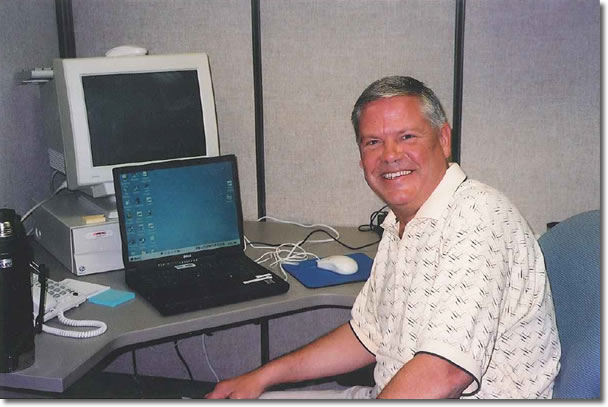 Former Minnesota Department of Health water operator certification officer Mark Sloan died March 9. He was 58.
Former Minnesota Department of Health water operator certification officer Mark Sloan died March 9. He was 58.
Mark came to MDH in 2004 with 13 years’ experience as a water operator. He had worked on general maintenance on distribution systems, operated a lime-softening water treatment plant, and served as the utility supervisor for water and sewer operations for the city of Richfield. He also worked for G. M. E. Consulting Engineers. He also had experience in construction inspection and materials testing.
Mark was a familiar face at water operator schools and was respected and well-liked by water operators and his co-workers at the health department. He retired in March 2017.
Go to top
Sustainability Key to Rochester Water
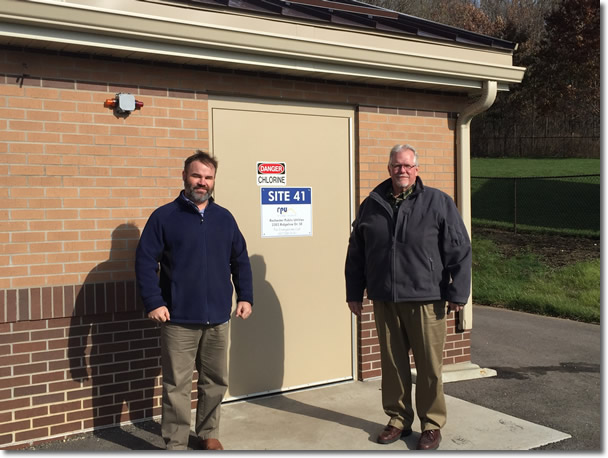
Doug Klamerus and Cary Johnson in front of Well 41
Disasters are opportunities for Rochester, Minnesota.
An August 1883 tornado, which left widespread destruction and 26 dead, led to the city’s first hospital, led by Dr. William Worrall Mayo and his sons. This was the beginning of the Mayo Clinic and the first sign of Rochester’s future as a medical center.
Nature tore through the city again nearly a century later—a flood that killed five and caused $60 million in damage. This disaster led to the “Renaissance of Rochester,” pulling the city out of a decade of stagnation and signaling the beginning of an era of unprecedented construction.
One of the city’s primary agencies, Rochester Public Utilities, has been working for years to make sure it does not have another kind of disaster—too little water. Groundwater planning, asset management, source water protection, and pro-active strategies are at the heart of sustainability efforts to ensure that the utility can continue to supply safe drinking water to a city that is growing, residentially and commercially.
Background and History
Rochester grew up on the south fork of the Zumbro River, which provided power from its falls but also feeder creeks that were prone to flooding.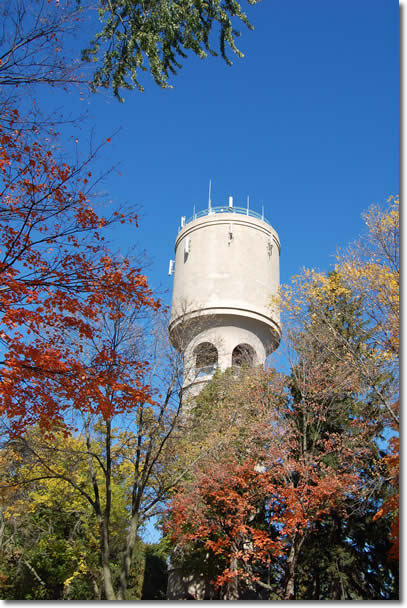
With safety a primary concern following the 1883 tornado, the city contracted with a private company, Hodgkins, Moffet, and Clark of Waterville, New York, to operate a water system although fire protection, not drinking water, was the primary motivation.
In 1916 the city purchased the water works company and began adding wells and storage facilities. The 1920s saw the addition of a chlorinator to disinfect the water and a major construction project, which included a 128-foot-high tower near St. Mary’s Hospital that holds 200,000 gallons. The tower, no longer in service but still a landmark for Rochester Public Utilities (RPU), provided adequate pressure to the area surrounding St. Mary’s Hospital and was the beginning of the high-level system still in use today.
Profile
Today Rochester has a population of more than 114,000 and expects annual growth of 1.6 percent for the next 10 years, according to Cary Johnson, RPU manager of maintenance and construction—water operations. In addition, the city is in the early stages of Destination Medical Center, a 20-year economic development initiative that includes expansion of the Mayo Clinic. Water design project coordinator Donn Richardson notes downtown redevelopment and more high-density apartments in the city as another reason for the growth.
The utility has 32 wells (and is adding another in 2018) and pumps approximately 4.7 billion gallons of water per year. (RPU pumped 4.49 million gallons in 2016.) The wells range in depth from 400 to 1,000 feet and draw mainly from the Jordan Aquifer, a sedimentary unit that underlies much of southeastern Minnesota. Other multi-formation aquifers—Prairie du Chien-Jordan, Prairie du Chien-Wonewoc, Jordan-Wonewoc, and Prairie duChien-Mt. Simon—supply water for Rochester.
The wells are interconnected, and the water is treated with chlorine, fluoride, and a polyphosphate for corrosion control at each site. Johnson noted the complexity of the distribution system, which has numerous pressure zones. Nineteen storage facilities hold nearly 17 million gallons of water.
Even though the customer base is growing, the per capita usage is going down says Sidney Jackson, RPU director of core services.
Senior civil engineer Doug Klamerus credits residents and businesses for understanding the need to conserve and use water wisely. “The community is seeing the big picture,” Klamerus said. “I see nothing but support for the conservation program.”
Sustainability
Todd Osweiler, environmental and regulatory affairs coordinator, said the announcement about Destination Medical Center, as well as other water concerns in the news, “brought up the question of how much we can keep on pumping.”
RPU has partnered with Barr Engineering of Minneapolis, the U. S. Geological Survey, and the Minnesota Department of Natural Resources on groundwater studies and evaluation. “We became pro-active about sustainability,” said Osweiler. “All this spurred more on sustainability.”
A sustainability evaluation has included input from stakeholders, review of existing data, groundwater modeling to determine the potential impact of future pumping, identification of data gaps that produce uncertainty in modeled predictions, and the development of a monitoring plan.
Osweiler outlined the four components RPU has for conservation and sustainability: leak detection, rate setting, water rebates, and education.
The utility performs a leak detection survey on half the system each year, using resources to find and fix leaks, resulting in water accountability of more than 95 percent.
Rates are set with a multi-tiered structure that rewards low usage. Commercial irrigation is the highest tier grade. “Use more, pay more,” says Klamerus.
RPU encourages residents to replace fixtures with ones that use less water and provides rebates for such purchases. Osweiler says in 2015 that RPU issued nearly 1,600 rebates that have resulted in savings of 8.8 million gallons.
At the heart of the sustainability effort is education. The more people understand all that is involved in producing and maintaining safe water, the more that are willing to do their part in protecting and conserving it.
Tours bring in school children, who are asked for their ideas on protecting water. Rochester has three times hosted the American Water Works Association Drinking Water Institute, a four-day summer program for Minnesota science teachers to learn about water and develop inquiry-based activities to integrate into their existing curriculum.
RPU Plugged In is a monthly publication with information on easy ways to conserve water and how to find leaks in homes as well as updates on what utility projects. RPU promotes drinking tap water instead of paying for bottled water by encouraging schools and business to install filling stations for reusable water bottles. The annual water quality report (Consumer Confidence Report) is included in one of the issues each year, and the utility has put coupons in the publication for residents to get a free water bottle.
It also offers a Service Assured Program for a monthly fee, which covers repairs on portions of the water system that belong to a resident, such as the service line.
Asset Management and Enhanced Sampling
RPU employs asset management to budget for future projects. A two-year study now underway will plan for the next 30 to 40 years, examining the life expectancy of current infrastructure and identifying critical assets and their impact on customers. Having a plan to rehabilitate or replace pumps, pipes, and storage facilities allow for controlled maintenance rather than crisis situations.
Water main repairs have historically been dictated by when and where street repairs were being made. Klamerus says a more collaborative approach, which includes the needs of RPU to replace or rehabilitate water infrastructure, is now part of the decision-making process for future street repairs. Klamerus said asset management planning is a way to gain a better understanding of the extent of financial investment needed to maintain our current level of customer service. If more investment is needed than current street repair projects allow, RPU will look at the most financially feasible option between full water main replacements or trenchless rehabilitation technology to maintain the utility’s infrastructure for additional projects.
In addition to planning to avoid dealing with emergencies, asset management is a budgeting tool, a way to avoid radical rate increases.
Beyond sampling for contaminants regulated under the federal Safe Drinking Water Act, RPU has been involved in a general chemistry project, testing under the Unregulated Contaminant Monitoring Rule, and special projects such as a pesticide study in conjunction with the Minnesota Department of Health (MDH) and Minnesota Department of Agriculture.
MDH district engineer Paul Halvorson said, “It is some of the most sampled water in the state. All of our data will help them in the future as they use their models to evaluate groundwater sustainability.”
RPU has 6 water operators and 11 people in the field with GPS in all trucks and iPads with all staff. Two of the trucks have a SCADA interface in them. “What helps me in getting samples in an efficient manner is the operator’s ability to operate the system remotely via SCADA in the truck,” says Halvorson. “With this, the operator can have the required wells running for a while before I get there, so it’s a quality, representative sample.”
As is the case with every water system, the quantity and quality of drinking water is paramount. Reliable service is necessary. Rochester Public Utilities serves a city that has been used to challenges from nature, and it is determined to not allow anything to disrupt the water service to Rochester residents.
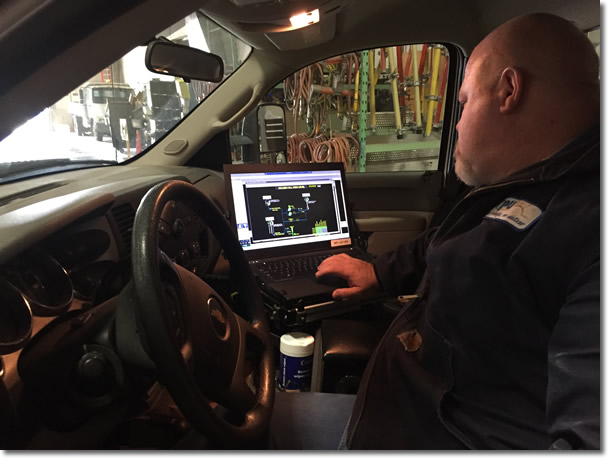
Rochester Public Utilities Scott Rendler in a SCADA truck.
Go to top
Lewis & Clark Summary
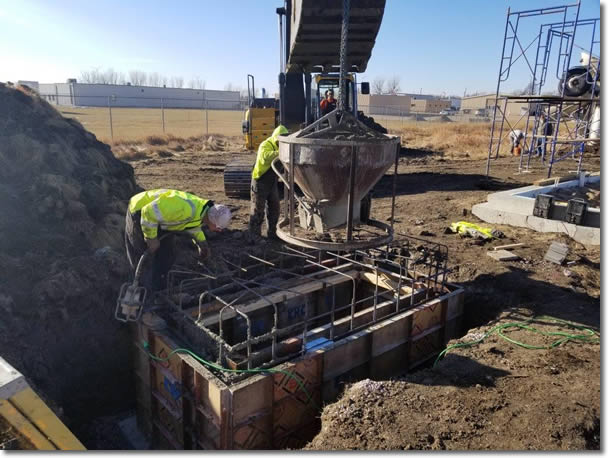
Work has resumed on the meter building in Worthington.
The Lewis & Clark Rural Water System has resumed construction of a meter building in Worthington and on the section of pipe between Adrian and Worthington. It addition, the reservoir and pump station for the Rock County Rural Water District have reached substantial completion.
Conceived in 1988 as a way of serving water-challenged areas in South Dakota, Iowa, and Minnesota, the Lewis & Clark project takes water from a series of wells that tap into an aquifer adjacent to the Missouri River near Vermillion, South Dakota. The water is delivered to communities as far away as 125 miles. The water first reached Minnesota in 2015, reaching Rock County Rural Water District.
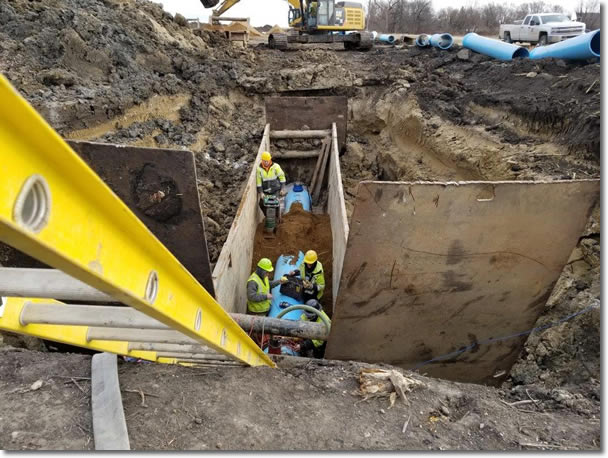
Trench packing and cathodic protection testing on the section of pipe between Adrian and Worthington.
Go to top
Austin Utilities Increases Capacity to Serve Major Spam Producer
Austin Utilities in Austin, Minnesota, opened a new municipal service center in July 2016, just to the north of a new well and above-ground storage facility. Well 12, which went on-line in 2013, was the city’s first new well since 1977. It was constructed after Hormel Corporation, manufacture of Spam and other cured meats, approached Austin Utilities about obtaining all of its water from Austin. The utility determined it could handle the increased demand, approximately 3.5 million gallons per day, with a high-capacity well and 2-million storage tank along with a mile of 16-inch pipe to get the water into its distribution system.
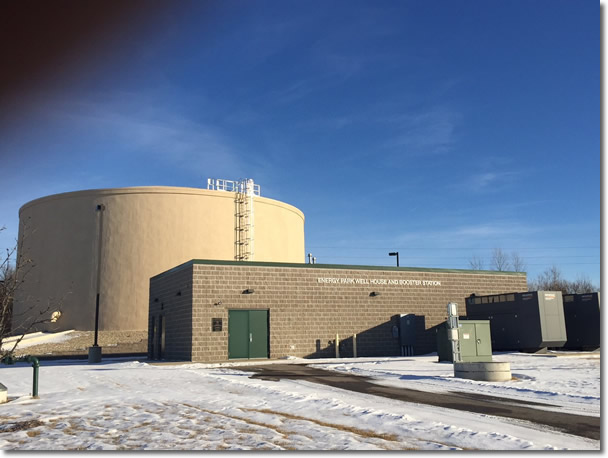 |
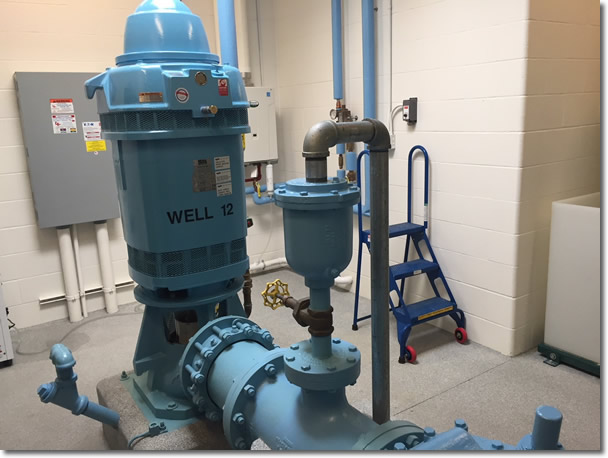 |
Hormel had been a noncommunity public water system. It worked with the Minnesota Department of Health to seal its wells and connect to the municipal supply. The utility bonded for the construction of the well, tank, and pipes and will benefit from the increased revenues by the sale of its water to Hormel. Austin has eight wells, ranging in depth from 110 to 1,075 feet, that draw from the Prairie du Chien-Jordan, Spillville, and St. Peter aquifers. The water is treated with chlorine, fluoride, and a polyphosphate.
In late 2017 Austin began demolishing its downtown power plant (below), which contained the original municipal wells. Austin Utilities will be working with staff from the Minnesota Department of Health to make sure all the abandoned wells are sealed. The letters from the historic sign atop the power plant were moved to one of the existing buildings at the municipal service center. Todd Jorgenson, the gas and water operations director, said the neon in the sign was retrofitted with LED lighting.
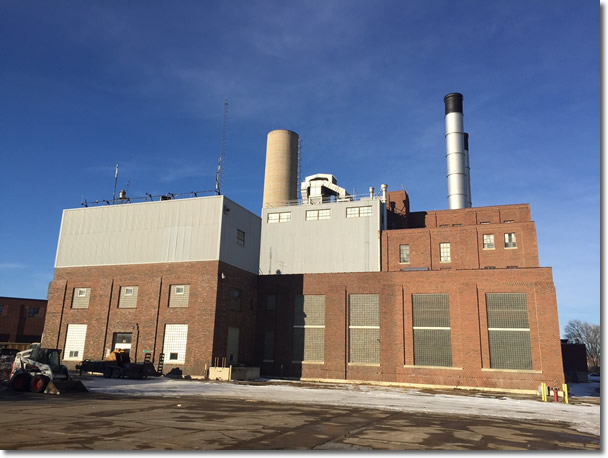 |
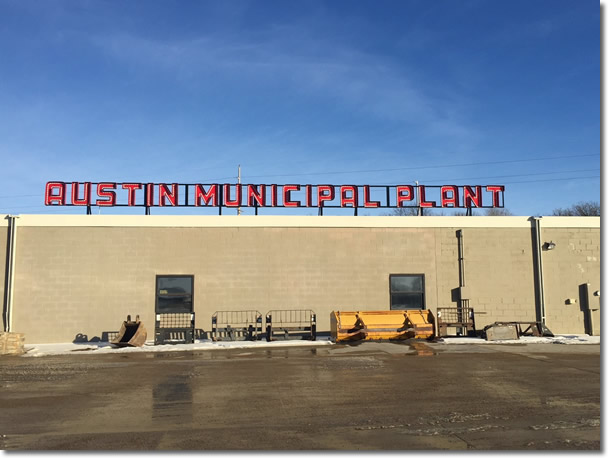 |
Go to top
Water Quality Incident? Contact the State Duty Officer
Water operators and superintendents are reminded that they should call the state duty officer at 800-422-0798 in the event of any type of water quality incident. This includes both intentional (break-in or vandalism) and unintentional (contamination, chemical overfeed) events. In addition to the duty officer, personnel should contact law enforcement if the incident was intentional. MDH has the phone numbers and more information on its website:
MDH Emergency Guidance for Community PWSs (PDF)
Go to top
2018 Drinking Water Institute August 6-8
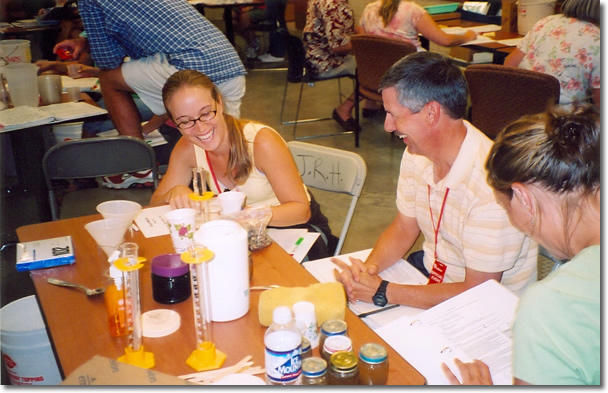
The 2018 WaterWorks! Drinking Water Institute for Educators will be held from August 6 to August 8 in Rochester.
Each year Minnesota science teachers attend the three-day Institute, learning about drinking water and about ways to develop inquiry-based activities that can be incorporated into their existing science curriculum. The program is free to teachers, who receive college credit for their participation.
WaterWorks! is sponsored by the Minnesota Department of Health and Minnesota American Water Works Association.
More information:
Water Works! A Drinking Water Institute for Educators
Go to top
Mankato Receives Source Water Protection Award
The city of Mankato received the annual Source Water Protection Award from Minnesota Department of Health (MDH) and Minnesota Rural Water Association for developing a comprehensive nitrate trend monitoring program, embarking on a public-education program to accelerate the sealing of abandoned wells, and developing a water conservation and reuse program to conserve source water.
Mankato has two Ranney wells, a type of horizontal collector well, that draw water from beneath the Minnesota and Blue Earth rivers. With assistance from a source water protection grant from MDH, the city collected and analyzed water quality data from their wells, the rivers, and treated water on a weekly basis. This data collection provides information to help ensure the city provides high quality water that meets and exceeds state and federal standards.
When Mankato adopted its Wellhead Protection Plan, city staff began identifying wells that needed to be sealed in addition to locating more abandoned wells. So far, three of four multi-aquifer wells have been sealed, and staff are looking to seal the last one.
Mankato also developed an innovative water conservation and reuse program. Since a goal is ensuring high quality water and long-term sustainability of the deep Mt. Simon wells, the city partnered with private industry, city departments, and state agencies to develop a reuse program. Wastewater treatment plant effluent is being provided to a power plant for cooling as well as for internal reuse, park irrigation, and a recycle water station. In 2016 Mankato reused approximately 184 million gallons of water and, with the installation of a backwash reuse upgrade, saved an additional 157 million gallons in 2017.
Go to top
Summit Brewing Company: It Starts with the Water
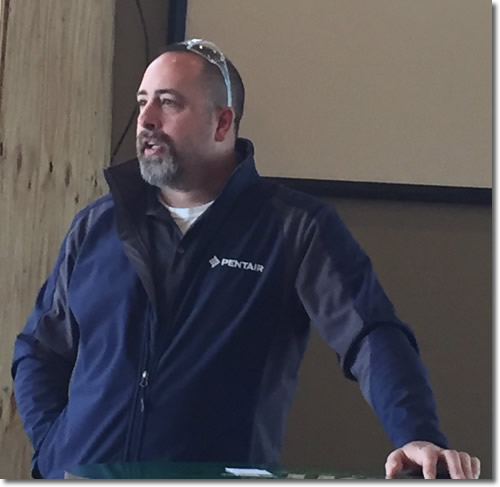 Though not a brewmaster himself, Tom Thomasser has “brew in his blood.” He is a fifth-generation member of a brewing family that includes a great grandfather who was a master brewer in Austria. Thomasser is now the chief operations officer of Summit Brewing Company in St. Paul, which began in 1986 in a reconditioned transmission shop on University Avenue between Minn. Hwy. 280 and Vandalia Avenue. Thomasser joined the company as it was moving to its current location, off West Seventh Street near I-35E, and was involved in the construction of the new facility and purchase of all equipment. Thus, Thomasser was well qualified to provide a tour of the plant to a group of water operators April 4, and he emphasized water as a primary ingredient in their process.
Though not a brewmaster himself, Tom Thomasser has “brew in his blood.” He is a fifth-generation member of a brewing family that includes a great grandfather who was a master brewer in Austria. Thomasser is now the chief operations officer of Summit Brewing Company in St. Paul, which began in 1986 in a reconditioned transmission shop on University Avenue between Minn. Hwy. 280 and Vandalia Avenue. Thomasser joined the company as it was moving to its current location, off West Seventh Street near I-35E, and was involved in the construction of the new facility and purchase of all equipment. Thus, Thomasser was well qualified to provide a tour of the plant to a group of water operators April 4, and he emphasized water as a primary ingredient in their process.
In 2017, Summit Brewing took in 19.5 million gallons from St. Paul Regional Water Services. It has a sand-and-gravel and carbon filter to remove chlorine from the water. In addition, it makes some adjustments during certain parts of the year for taste and odor. Thomasser said they also do some “tweaking” to the process water in individual recipes. “We try to make the water similar to what it would have been in its home world,” he said, explaining, for example, that their Dakota Soul label is a Czech-style Pilsner. The brewery may harden or acidify the water to mimic the qualities of the water in the Czech Republic.
Summit also has to treat the effluent, sometimes neutralizing the pH and keeping tabs on the temperature of the water as it discharges it. In addition to water as an ingredient for its beers, the brewery relies on water for sanitation, especially in the filtration process. The water may be heated to as much as 180 degrees in its brew kettles and then cooled before reaching the fermentation vessels.
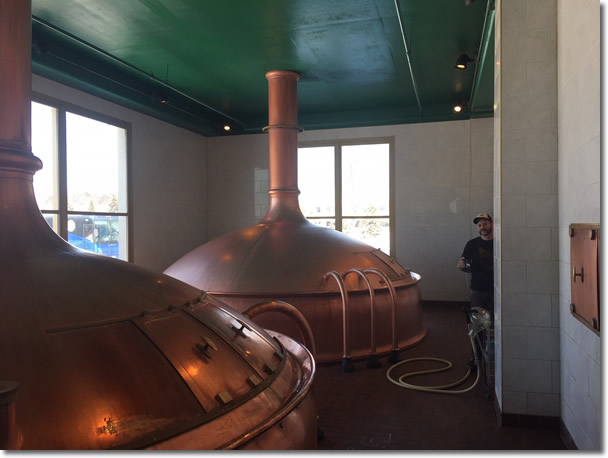 |
|
Above: The brew kettles at Summit Brewing Company. Below: The fermentation center. |
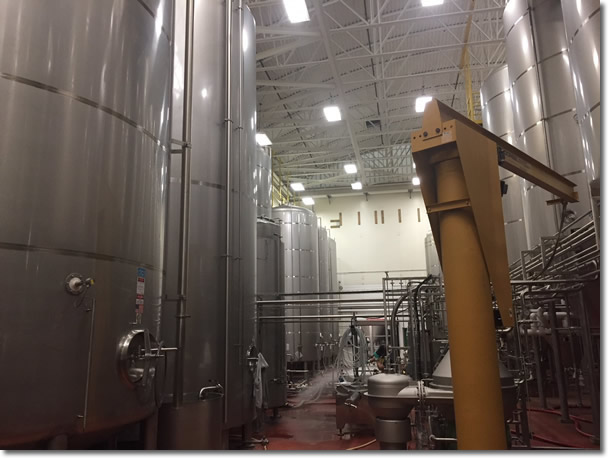 |
Go to top
Invisible Heroes Videos Highlight Drinking Water Providers
The Minnesota Department of Health has produced a series of Invisible Heroes videos, profiling water systems in Fairmont, St. Cloud, St. Martin, Worthington, New Brighton, and Oakdale. Each of these systems has overcome challenges to continue to provide safe drinking water to its residents. The videos are available on the MDH web site:
Go to top
We Are Water MN Visits the Capitol

We Are Water MN was on display at the Minnesota state capitol from January 10 to March 11 before moving on to the Hjemkomst Center in Moorhead. The traveling display explores the connections between the humanities and water through an exhibit, public events, and educator resources. We Are Water MN is a partnership involving a number of state agencies, including the Minnesota Department of Health, to bring together personal stories, historical materials, and scientific information. In 2018-2019, the exhibit will be on display in Minneapolis, Bemidji, Crookston, Fond du Lac/Cloquet, Austin, Northfield, Grand Rapids, and Mille Lacs/Onamia.
Schedule and more information: We Are MN Traveling Exhibit
Go to top
Words to Live By
The way to succeed is to double your failure rate.
—Thomas J. Watson, IBM Corporation Founder
The remedy to free-speech controversies is more free speech.
—former University of Minnesota president Nils Hasselmo
If you compete with everyone else, you will become bitter. If you compete with a previous version of yourself, you will become better.
Go to top
Reminder to All Water Operators
When submitting water samples for analyses, remember to do the following:
- Take coliform samples on the distribution system, not at the wells or entry points.
- Write the Date Collected, Time Collected, and Collector’s Name on the lab form.
- Sign the form where it says "Relinquished by."
- Write the Sample Point on the laboratory.
- Attach the label to each bottle (do not attach labels to the lab form).
- Include laboratory request forms with submitted samples.
- Do not use a rollerball or gel pen (the ink may run).
- Consult your monitoring plan(s) prior to collecting required compliance samples.
Notify your Minnesota Department of Health district engineer of any changes to your systems.
If you have questions, call the Minnesota Department of Health contact on the back of all sample instruction forms.
Calendar
Operator training sponsored by the Minnesota Department of Health and the Minnesota AWWA will be held in several locations this spring.
Register for schools and pay on-line:
Go to top